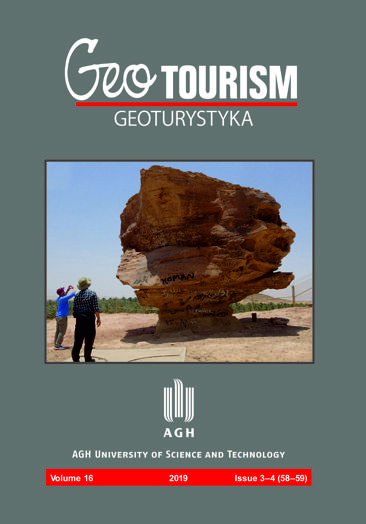Land of Extinct Volcanoes Geopark – geoeducation for everyone
DOI:
https://doi.org/10.7494/geotour.2019.58-59.16Keywords:
The Kaczawskie Mountains and Foothills, geoeducation, geotourismAbstract
The Kaczawskie Mountains and Foothills – Geopark Land of Extinct Volcanoes is an area with an extremely interesting geological structure and outstanding landscape values. Great geo-diversity makes it possible to prepare a geoeducation offer for practically every recipient – from kids, through adults interested in natural sciences, to natural science students. The characteristics of the Kaczawskie Mountains and Foothills enable one to develop a nationally unique form of geotourism and utilization of local natural resources for various geoeducation programs. Despite the small area of the mentioned region, it is possible to raise topics related to volcanic phenomena, the formation of mountain ranges, climate change and the impact of glaciers on the relief of the terrain. Educational activity at the Geopark Land of Extinct Volcanoes do not need to be limited only to geological issues, but may also include environmental issues, waste management or even historical topics. However, apart from the very existence of geotourism attractions, equally important are their uniform promotion and dissemination of knowledge about them. This can be done by describing the most important geopoints in the field, e.g. through a network of educational boards or by organizing promotional field trips. This would increase the knowledge about the geological richness of the described region among tourists and residents. The work of the Kaczawskie Association, which is trying to include the Land of Extinct Volcanoes Geopark in the UNESCO World Geopark Network, is currently heading in this direction. The implementation of this initiative will not only increase the interest in natural sciences and the region, but will also allow it to keep its authentic and unique character. Unfortunately, the process of application to the UNESCO GGN, both the development of the geoeducation and geotourism in the region of the Kaczawskie Mountains and Foothills, has been slowed down by the COVID-19 pandemic.Downloads
References
Awdankiewicz M., 2006. Fractional crystallization, mafic replenishment and assimilation in crustal magma chambers: geochemical constraints from the Permian post-collisional intermediate-composition volcanic suite of the North-Sudetic Basin (SW Poland). Geologia Sudetica, 38: 39–61.
Baranowski Z., Haydukiewicz A., Kryza R., Lorenc S., Muszyński A., Solecki A., Urbanek Z., 1990. Outline of the geology of the Gory Kaczawskie (Sudetes, Poland). Neues Jahrbuch für Geologie und Paläontologie, 179, 223–257.
Białek D., Raczyński P., Sztajner P., Zawadzki D., 2007. Archeocjaty wapieni wojcieszowskich. Przegląd Geologiczny, 55(12/2): 1112–1116.
Birkenmajer K., Pécskay Z., Grabowski J., Lorenc M.W., Zagożdżon P., 2007. Radiometric dating of the Tertiary volcanics in Lower Silesia, Poland. V. K-ar and palaeomagnetic data from late Oligocene to early Miocene basaltic rocks of the north-sudetic depression. Annales Societatis Geologorum Poloniae, 77(1): 1–16.
Cwojdziński S., Jodłowski S., 1982. “Plamowe” koncentracje bazaltowe Masywu Czeskiego i Dolnego Śląska. Biuletyn Instytutu Geologicznego, 341: 201–222.
Golonka J., Barmuta M., Barmuta J., 2018. Kaczawa Klippen Belt – geotouristic attraction in the Sudety Mountains, SW Poland. Acta Geoturistica, 9(1): 30–35. https://doi.org/10.1515/agta-2018-0004.
Inwentaryzacja geopunktów na obszarze Partnerstwa Kaczawskiego, 2019. https://www.gorykaczawskie.pl/do-pobrania/ [accessed: 2020.12.16].
Kanikowski P., 2019. WUG: rezerwat Wilcza Góra nie został naruszony. https://24legnica.pl/wug-rezerwat-wilcza-gora-nie-zostal-naruszony/[accessed: 2020.12.16].
Kubaliková L., Bajer A., Kirchner K., 2016. Secondary geodiversity and its potential for geoeducation and geotourism: a case study from Brno city. Public recreation and landscape protection, 224-231.
Land of Extinct Volcanoes Geopark Application Dossier, 2019. https://www.gorykaczawskie.pl/do-pobrania/ [accessed: 2020.12.16].
Marek P., Patla S., Rogosz K., 2014. Projektowanie rekultywacji na przykładzie kopalni Wilcza Góra. Mining Science, 21, Special issue 1: 151–158.
Mazur S., Aleksandrowski P., Kryza R., Oberc-Dziedzic T., 2006. The Variscan Orogen in Poland. Geological Quarterly, 50(1): 89–118.
Mazur S., Aleksandrowski P., Szczepański J., 2010. Zarys budowy i ewolucji tektonicznej waryscyjskiej struktury Sudetów. Przegląd Geologiczny, 58(10): 133–145.
Milewicz J., 1985. A proposal of formal stratigraphic subdivision of the infill of the North Sudetic Depression. Przegląd Geologiczny, 33: 359–389.
Ostromęcki A., 1972. Profil litostratygraficzny permo-karbonu w zachodniej części Rowu Świerzawy. Geologia Sudetica, 6(1):
–306.
Pijet-Migoń E., Migoń P., 2019. Promoting and interpreting geoheritage at the local level – bottom-up approach in the Land of Extinct Volcanoes, Sudetes, SW Poland. Geoheritage, 11(4): 1227–1236. https://doi.org/10.1007/s12371-019-00357-2.
Solecki A., 2011. Rozwój strukturalny epiwaryscyjskiej pokrywy platformowej w obszarze synklinorium północnosudeckiego. In: Żelaźniewicz A., Wojewoda J., Ciężkowski W. (red.), Mezozoik i kenozoik Dolnego Śląska. Przewodnik 81 Zjazdu PTG, 19–36.
Szumowska M., Awdankiewicz M., Christiansen E., 2013. Geology and petrology of Cenozoic volcanic rocks of Ostrzyca Hill in the Kaczawa Foothills. Mineralogia – Special Papers, 41: 88.
Wojewoda J., Mastalerz K., 1989. Ewolucja klimatu oraz allocykliczność i autocykliczność sedymentacji na przykładzie osadów kontynentalnych górnego karbonu i permu w Sudetach. Przegląd Geologiczny, 432, 173–180.
Downloads
Published
Issue
Section
License
Copyright (c) 2021 Geotourism/Geoturystyka

This work is licensed under a Creative Commons Attribution 3.0 Unported License.

The content of the journal is freely available according to the Creative Commons License Attribution 4.0 International (CC BY 4.0).


